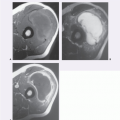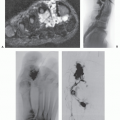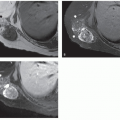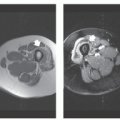Adipocytic tumors |
Benign |
|
Lipoma |
|
Lipomatosis |
|
Lipomatosis of nerve |
|
Lipoblastoma/lipoblastomatosis |
|
Angiolipoma |
|
Myolipoma |
|
Chondroid lipoma |
|
Extra-renal angiomyolipoma |
|
Extra-adrenal myelolipoma |
|
Spindle cell lipoma/pleomorphic lipoma |
|
Hibernoma |
Intermediate (locally aggressive) |
|
Atypical lipomatous tumor/well-differentiated liposarcoma |
Malignant |
|
Dedifferentiated liposarcoma |
|
Myxoid liposarcoma |
|
Pleomorphic liposarcoma |
|
Liposarcoma, not otherwise specified |
Fibroblastic/myofibroblastic tumors |
Benign |
|
Nodular fasciitis |
|
Proliferative fasciitis |
|
Proliferative myositis |
|
Myositis ossificans |
|
Fibro-osseous pseudotumor of digits |
|
Ischemic fasciitis |
|
Elastofibroma |
|
Fibrous hamartoma of infancy |
|
Fibromatosis coli |
|
Juvenile hyaline fibromatosis |
|
Inclusion body fibromatosis |
|
Fibroma of tendon sheath |
|
Desmoplastic fibroblastoma |
|
Mammary-type myofibroblastoma |
|
Calcifying aponeurotic fibroma |
|
Angiomyofibroblastoma |
|
Cellular angiofibroma |
|
Nuchal-type fibroma |
|
Gardner fibroma |
|
Calcifying fibrous tumor |
Intermediate (locally aggressive) |
|
Palmar/plantar fibromatosis |
|
Desmoid-type fibromatosis |
|
Lipofibromatosis |
|
Giant cell fibroblastoma |
Intermediate (rarely metastasizing) |
|
Dermatofibrosarcoma protuberans |
|
|
Fibrosarcomatous dermatofibrosarcoma protuberans |
|
|
Pigmented dermatofibrosarcoma protuberans |
|
Solitary fibrous tumor |
|
Inflammatory myofibroblastic tumor |
|
Low-grade myofibroblastic sarcoma |
|
Myxoinflammatory fibroblastic sarcoma |
|
Infantile fibrosarcoma |
Malignant |
|
Adult fibrosarcoma |
|
Myxofibrosarcoma |
|
Low-grade fibromyxoid sarcoma |
|
Sclerosing epithelioid fibrosarcoma |
So-called fibrohistiocytic tumors |
Benign |
|
Tenosynovial giant cell tumor |
|
|
Localized type |
|
|
Diffuse-type |
|
|
Malignant |
|
Deep benign fibrous histiocytoma |
Intermediate (rarely metastasizing) |
|
Plexiform fibrohistiocytic tumor |
|
Giant cell tumor of soft tissue |
Smooth muscle tumors |
Benign |
|
Deep leiomyoma |
Malignant |
|
Leiomyosarcoma (excluding skin) |
Pericytic (perivascular) tumors |
|
Glomus tumor (and variants) |
|
|
Glomangiomatosis |
|
|
Malignant glomus tumor |
|
Myopericytoma |
|
|
Myofibroma |
|
|
Myofibromatosis |
|
Angioleiomyoma |
Skeletal muscle tumors |
Benign |
|
Rhabdomyoma |
|
|
Adult type |
|
|
Fetal type |
|
|
Genital type |
Malignant |
|
Embryonal rhabdomyosarcoma (including botroyoid, anaplastic) |
|
Alveolar rhabdomyosarcoma |
|
Pleomorphic rhabdomyosarcoma |
|
Spindle cell/sclerosing rhabdomyosarcoma |
Vascular tumors |
Benign |
|
Hemangiomas |
|
|
Synovial |
|
|
Venous |
|
|
Arteriovenous hemangioma/malformation |
|
|
Intramuscular |
|
Epithelioid hemangioma |
|
Angiomatosis |
|
Lymphangioma |
Intermediate (locally aggressive) |
|
Kaposiform hemangioendothelioma |
Intermediate (rarely metastasizing) |
|
Retiform hemangioendothelioma |
|
Papillary intralymphatic angioendothelioma |
|
Composite hemangioendothelioma |
|
Pseudomyogenic (epithelioid sarcoma-like) hemangioendothelioma |
|
Kaposi sarcoma |
Malignant |
|
Epithelioid hemangioendothelioma |
|
Angiosarcoma of soft tissue |
Chondro-osseous tumors |
|
Soft tissue chondroma |
|
Mesenchymal chondrosarcoma |
|
Extraskeletal osteosarcoma |
Gastrointestinal Stromal Tumors |
|
Benign gastrointestinal stromal tumor |
|
Gastrointestinal stromal tumor, uncertain malignant potential |
|
Benign gastrointestinal stromal tumor, malignant |
Nerve Sheath Tumors |
Benign |
|
Schwannoma |
|
Melanotic schwannoma |
|
Neurofibroma |
|
|
Plexiform neurofibroma |
|
Perineurioma |
|
|
Malignant perineurioma |
|
Granular cell tumor |
|
Dermal nerve sheath myxoma |
|
Solitary circumscribed neuroma |
|
Extopic meningioma |
|
Benign triton tumor |
|
Hybrid nerve sheath tumor |
Malignant |
|
Malignant peripheral nerve sheath tumor (MPNST) |
|
Epithelioid malignant peripheral nerve sheath tumor |
|
Malignant triton tumor |
|
Malignant granular cell tumor |
|
Ectomesenchymoma |
Tumors of Uncertain Differentiation |
Benign |
|
Acral fibromyxoma |
|
Intramuscular myxoma |
|
Juxta-articular myxoma |
|
Deep (“aggressive”) angiomyxoma |
|
Pleomorphic hyalinizing angiectatic tumor |
|
Ectopic hamartomatous thymoma |
Intermediate (locally aggressive) |
|
Hemosiderotic fibrolipomatous tumor |
Intermediate (rarely metastasizing) |
|
Atypical fibroxanthoma |
|
Angiomatoid fibrous histiocytoma |
|
Ossifying fibromyxoid tumor |
|
Mixed tumor |
|
Myoepithelioma |
|
Myoepithelial carcinoma |
|
Phosphaturic mesenchymal tumor |
Malignant |
|
Synovial sarcoma |
|
Epithelioid sarcoma |
|
Alveolar soft-part sarcoma |
|
Clear cell sarcoma of soft tissue |
|
Extraskeletal myxoid chondrosarcoma |
|
Extraskeletal Ewing tumor |
|
Desmoplastic small round cell tumor |
|
Extra-renal rhabdoid tumor |
|
Neoplasms with perivascular epithelioid cell differentiation (PEComa) |
|
|
PEComa, benign |
|
|
PEComa, malignant |
|
Intimal sarcoma |
Undifferentiation/Unclassified Sarcomas |
|
Undifferentiated spindle cell sarcoma |
|
Undifferentiated pleomorphic sarcoma |
|
Undifferentiated round cell sarcoma |
|
Undifferentiated epithelioid sarcoma |
|
Undifferentiated sarcoma, NOS |
* Adapted from Reference 10 |








